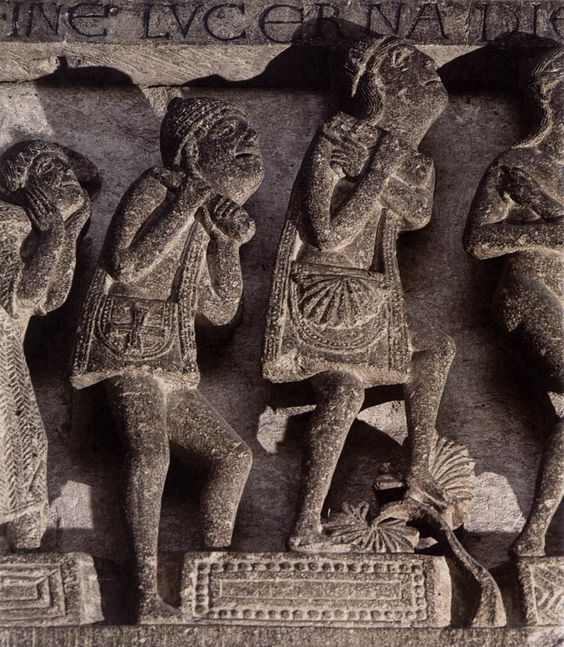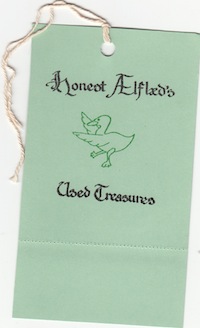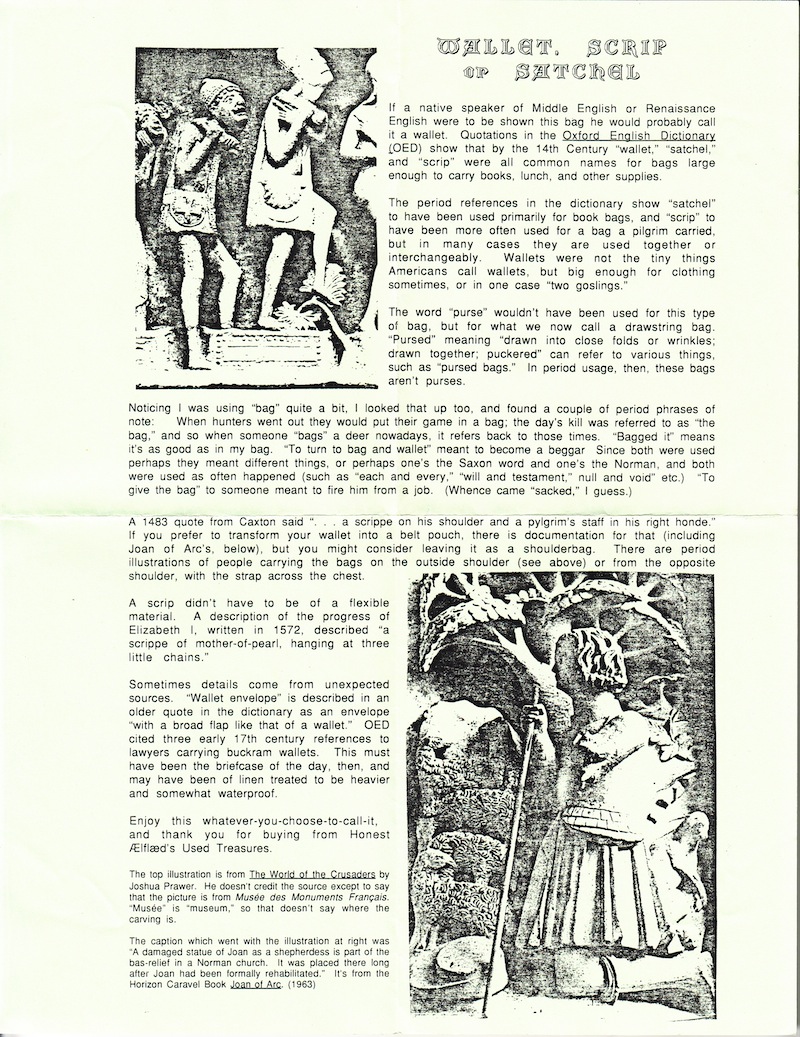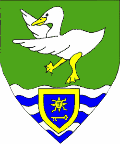
(click to enlarge)
First, the text of the PDF below, so that it's searchable and more easily readable.

The period references in the dictionary show "satchel" to have been used primarily for book bags, and "scrip" to have been more often used for a bag a pilgrim carried, but in many cases they are used together or interchangeably. Wallets were not the tiny things Americans call wallets, but big enough for clothing sometimes, or in one case "two goslings."
The word "purse" wouldn't have been used for this type of bag, but for what we now call drawstring bag. "Pursed" meaning "drawn into close foldd or wrinkles; drawn together; puckered" can refer to various things, such as "pursed bags." In period usage then, these bags aren't purses.
Noticing I was using "bag" quite a bit, I looked that up too, snd found a couple of period phrases of note. When hunters went out they would put their game in a bag;the day's kill was referred to as "the bag," and so when someone "bags" a deer nowadays, it refers back to those times. "Bagged it" means it's as good as in my bag. "To turn to bag and wallet" meant to become a beggar. Since both were used perhaps they meant different things, or perhaps one's the Saxon word and one's the Norman, and both were used as often happened (such as "each and every," "will and testament," "null and void" etc.). "To give the bag" to someone meant to fire him from a job. (Whence came "sacked, I guess.)
A 1483 quote from Caxton said ". . . a scrippe on his shoulder and a pylgrim's staff in his right honde."
If you prefer to transform your wallet into a belt pouch, there is documentation for that (including Joan of Arc's, below), but you might consider leaving it as a shoulderbag. There are period illustrations of people carrying the bags on the outside shoulder (see above) or from the opposite shoulder, with the strap across the chest.
A scrip didn't have to be of a flexible material. A description of the progress of Elizabeth I, written in 1572, described "a scrippe of mother-of-pearl, hanging at three little chains."
Sometimes details come from unexpected sources. "Wallet envelope" is described in an older quote in the dictionary as an envelope "with a broad flap like that of a wallet." OED cited three early 17th century references to lawyers carrying buckram wallets. This must have been the briefcase of the day, then, and may have been of linen treated to be heavier and somewhat waterproof.
Enjoy this whatever-you-choose-to-call-it, and thank you for buying from Honest Ælflæd's Used Treasures.
I used to have a hobby-within-a-hobby, Honest Ælflæd's Used Treasures. I bought things from thrift stores, yard sales and the flea market to re-sell within the SCA. By knowing what looked period and what didn't, and being aware of what people needed and what was too breakable or unpopular (artistically), I was able to make enough to pay for site fees and gasoline to events for Gunwaldt and me for a while. After we had children, the shop faded pretty quickly, which was fine. It had been fun.

The selling of used things in the regular world has waves in it. Many things in thrift stores and charity shops are 20 years old. Not old enough to be antique; old enough to be embarrassing and irritating to have around, though, to some people. Then there are the clean-outs from older people who, from infirmity or worse, leave their homes and all their stuff is taken away.
It was the former condition that once filled shops with leather shoulderbags from the 1960's and 70's. Tandy Leather Company used to sell kits for making shoulder bags without any metal fittings—only punched and laced, or sewn otherwise. There were other patterns that involved only rivets. Then there were variations created in that fashion by hippie craftsmen, of that leather called "oak" and of suede and rough-out. NICE, solid bags, but they were only popular for a decade, and hit the thrift stores in the late 1980's and early 1990s. I bought dozens of them.
When we went to the SCA's 25th anniversary, I took a few dozen of those, with a Gunwaldt-made display rack, and another merchant undertook to sell them for me, because I was teaching five classes and had two young boys and a teenaged child-minder with me.
In part because I wouldn't be there to talk to people, and more because I had the urge to document, I left a folded sheet of explanation inside each bag. I came across the extras the other day (in October 2011), and thought it might be worth sharing. It's documentation by statues and dictionaries, and in this case, there's not going to be much better. Feel free to copy or share.
| If you click the jpg file below, it will open a PDF. This was in the days of physical paste-up. The text was done with Word on a Mac IISi and a laser printer, and photocopies of photos were taped on the original and then Xeroxed. The original paper was green, but my scanner couldn't imagine I really wanted that still. |

The top illustration is from The World of the Crusaders by Jushua Prawer. He doesn't credit the source except to say that the picture is from Musée des Monuments Français.. "Musée" is "museum," so that doesn't say where the carving is.Credits for photos used above, newly found in 2023:The caption [that] went with the illustation at right was "A damaged statue of Joan as a shepherdess is part of the bas-relief in a Norman church. It was placed there long after Joan had been formally rehabilitated." It's from the Horizon Caravel Book Joan of Arc (1963).
Pilgrims (detail) from the tympanum by Gislebertus @ Autun Cathedral, France. Romanesque. (Someone on Pinterest found this on a site called https://www.lib-art.com/)
